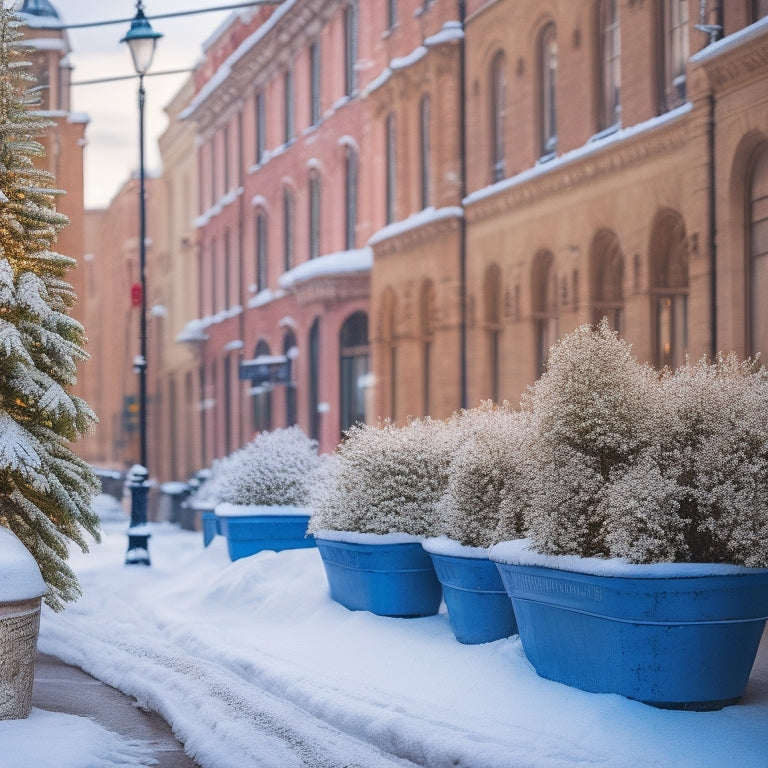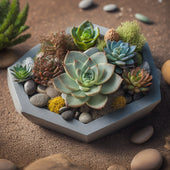
Frosty Urban Gardening: Overcoming Winter's Chill
Share
As an urban gardener, you can overcome winter's chill by adopting smart strategies to protect your plants. Start by choosing frost-tolerant varieties and taking measures to prevent frost damage, like using row covers and removing damaged foliage. Since winter days are short, maximize limited sunlight with mirrors, grow lights, or south-facing windows. Don't forget to protect your soil with winter mulching and organic matter to retain moisture and regulate temperature. Finally, shield your plants from harsh winds with physical barriers or natural windbreaks. By implementing these tips, you'll be well on your way to thriving in the cold - and there's more to discover.
Key Takeaways
• Frost damage can be minimized by using frost-tolerant plant varieties, frost blankets, and relocating potted plants indoors.
• Mirrors, reflectors, and grow lights can enhance limited winter sunlight and promote healthy plant growth.
• Winter mulching and soil amendments can improve soil quality by retaining moisture, suppressing weeds, and regulating soil temperature.
• Selecting hardy, frost-resistant plant varieties and providing protection for sensitive plants can ensure winter gardening success.
• Physical barriers, windbreaks, and protective coverings can shield plants from harsh winter winds and prevent windburn, desiccation, and soil erosion.
Frost Damage in Urban Gardens
As you venture into urban gardening during the winter months, you'll likely encounter one of the most significant challenges: frost damage, which can quickly turn your thriving plants into limp, lifeless specimens. To mitigate this risk, it's crucial to develop urban frost awareness, understanding the signs of frost damage and taking proactive measures to prevent it.
Frost damage can occur when temperatures drop below 32°F (0°C), causing water within plant cells to freeze and expand, ultimately leading to cell death. To recover from frost damage, employ frost recovery techniques such as gently removing any damaged foliage, providing adequate moisture, and applying a balanced fertilizer to promote new growth.
Additionally, consider using frost-tolerant plant varieties, installing frost blankets or row covers, and bringing potted plants indoors or to a protected area during extreme cold snaps.
Limited Sunlight in Winter
During winter, you'll face another significant challenge in urban gardening: limited sunlight, which can hinder plant growth and development, especially when your garden receives only 10 hours of daylight or less. This reduction in sunlight can be detrimental to your plants, making it essential to find ways to supplement their light intake.
Here are some winter gardening tips to help you overcome limited sunlight:
-
Mirrors and Reflectors: Use mirrors or reflectors to bounce available sunlight onto your plants, increasing their exposure to direct light.
-
Grow Lights: Invest in grow lights, which can provide the necessary spectrum and intensity of light for your plants to thrive.
-
South-Facing Windows: If possible, move plants to south-facing windows to maximize their exposure to natural sunlight.
- Supplemental Lighting: Consider using supplemental lighting, such as LED lights, to provide additional light for your plants during the winter months.
Soil Quality in Cold Climates
While you're finding ways to boost your plants' light intake, don't forget that cold weather also affects the soil quality in your urban garden. Soil amendments become essential in winter as the cold temperature slows down microbial activity, affecting nutrient availability. Winter mulching helps retain soil moisture, suppress weeds, and regulate soil temperature.
Here's a breakdown of how different soil types respond to cold weather and the corresponding solutions:
| Soil Type | Effects of Cold Weather | Solution |
|---|---|---|
| Clay | Waterlogging, nutrient deficiency | Add organic matter, like compost, to improve drainage and structure |
| Sandy | Poor water retention, erosion | Apply winter mulch to retain moisture and reduce erosion |
| Loamy | Reduced microbial activity | Use soil amendments like manure or blood meal to boost microbial activity |
Frost-Sensitive Plant Selection
When selecting plants for your urban garden, you'll want to choose varieties that can thrive in cold climates, or take steps to protect those that are more frost-sensitive. Frost resistant varieties, such as kale, spinach, and Brussels sprouts, are great options for outdoor gardens.
However, if you want to grow more delicate plants, consider indoor gardening or taking measures to protect them from frost.
Here are some tips to keep in mind when selecting plants for your winter garden:
-
Choose hardy plants: Look for plants that are specifically bred for cold climates or have natural defenses against frost.
-
Consider indoor gardening: Move sensitive plants indoors or start seeds in pots that can be brought inside during harsh weather.
-
Select varieties with built-in protection: Some plants, like cabbage and broccoli, have natural defenses against frost, such as thick leaves or waxy coatings.
- Research frost-tolerant cultivars: Many plants have cultivars that are specifically bred to be more frost-tolerant, such as 'Winterkeeper' lettuce or 'Frosty' kale.
Protecting Plants From Harsh Winds
You'll also need to shield your plants from harsh winter winds, which can cause just as much damage as frost, by creating a protective barrier around your garden beds.
Windbreak strategies are vital to prevent windburn, desiccation, and soil erosion. One effective approach is to install a physical barrier, such as a burlap screen or a snow fence, around the perimeter of your garden. This will block the wind and reduce its damaging effects.
Another option is to use protective coverings, like row covers or individual plant covers, to shield your plants from the wind. These lightweight, breathable fabrics allow for air and water to reach your plants while keeping the wind out.
You can also use natural windbreaks, such as evergreen boughs or shrubs, to create a barrier around your garden. By implementing these windbreak strategies, you'll be able to protect your plants from harsh winter winds and guarantee a healthy and thriving garden throughout the winter months.
Frequently Asked Questions
Can I Grow Citrus Trees in Frost-Prone Urban Gardens?
You crave the sweet scent of citrus in your urban garden, but frosty winters threaten to kill the dream. Fear not! You can grow citrus trees by selecting frost-tolerant varieties and mastering frost protection techniques like wrapping and bringing plants indoors.
How Often Should I Water My Plants During Winter?
You'll want to adjust winter watering techniques, as plants require less hydration. Check soil moisture weekly, and water only when it feels dry to the touch, ensuring ideal plant hydration frequency without overwatering.
Are There Any Benefits to Using Cold Frames in Urban Gardens?
You'll reap several benefits using cold frames in your urban garden, including extended growing seasons, increased crop yields, and improved soil health, making them a valuable addition to your urban gardening techniques.
Can I Start Seeds Indoors During the Winter Months?
You can start seeds indoors during winter months, but make sure you provide sufficient indoor lighting, as most seeds require 12-16 hours of light to germinate, and maintain a consistent temperature between 65-75°F for ideal growth.
Do I Need to Bring Potted Plants Inside During Harsh Winters?
'Did you know 60% of plants die from winter damage? You'll want to bring potted plants inside during harsh winters to guarantee proper potted plant care and winter plant protection, shielding them from frost and freezing temperatures.'
Related Posts
-

Why Succulents Thrive in DIY Concrete Planters
You've likely noticed that succulents seem to flourish in DIY concrete planters, and it's not just a coincidence - th...
-

Why Succulents Thrive in DIY Concrete Planters
You've likely noticed that succulents seem to flourish in DIY concrete planters, and it's not just a coincidence - th...
-

Why Succulents Thrive in DIY Concrete Planters
You've likely noticed that succulents seem to flourish in DIY concrete planters, and it's not just a coincidence - th...
-

Why Succulents Thrive in DIY Concrete Planters
You've likely noticed that succulents seem to flourish in DIY concrete planters, and it's not just a coincidence - th...
-

Why Succulents Thrive in DIY Concrete Planters
You've likely noticed that succulents seem to flourish in DIY concrete planters, and it's not just a coincidence - th...
-

Why Succulents Thrive in DIY Concrete Planters
You've likely noticed that succulents seem to flourish in DIY concrete planters, and it's not just a coincidence - th...
-

Why Succulents Thrive in DIY Concrete Planters
You've likely noticed that succulents seem to flourish in DIY concrete planters, and it's not just a coincidence - th...
-

Why Succulents Thrive in DIY Concrete Planters
You've likely noticed that succulents seem to flourish in DIY concrete planters, and it's not just a coincidence - th...
-

Why Succulents Thrive in DIY Concrete Planters
You've likely noticed that succulents seem to flourish in DIY concrete planters, and it's not just a coincidence - th...
-

Why Succulents Thrive in DIY Concrete Planters
You've likely noticed that succulents seem to flourish in DIY concrete planters, and it's not just a coincidence - th...
-

Why Succulents Thrive in DIY Concrete Planters
You've likely noticed that succulents seem to flourish in DIY concrete planters, and it's not just a coincidence - th...
-

Why Succulents Thrive in DIY Concrete Planters
You've likely noticed that succulents seem to flourish in DIY concrete planters, and it's not just a coincidence - th...
-

Why Succulents Thrive in DIY Concrete Planters
You've likely noticed that succulents seem to flourish in DIY concrete planters, and it's not just a coincidence - th...
-

Why Succulents Thrive in DIY Concrete Planters
You've likely noticed that succulents seem to flourish in DIY concrete planters, and it's not just a coincidence - th...
-

Why Succulents Thrive in DIY Concrete Planters
You've likely noticed that succulents seem to flourish in DIY concrete planters, and it's not just a coincidence - th...
-

Why Succulents Thrive in DIY Concrete Planters
You've likely noticed that succulents seem to flourish in DIY concrete planters, and it's not just a coincidence - th...
-

Why Succulents Thrive in DIY Concrete Planters
You've likely noticed that succulents seem to flourish in DIY concrete planters, and it's not just a coincidence - th...
-

Irrigation System Design Ideas for Concrete Planters
As you design an irrigation system for your concrete planters, you'll need to balance drainage, moisture retention, a...
-

Irrigation System Design Ideas for Concrete Planters
As you design an irrigation system for your concrete planters, you'll need to balance drainage, moisture retention, a...
-

Irrigation System Design Ideas for Concrete Planters
As you design an irrigation system for your concrete planters, you'll need to balance drainage, moisture retention, a...
-

Irrigation System Design Ideas for Concrete Planters
As you design an irrigation system for your concrete planters, you'll need to balance drainage, moisture retention, a...
-

Irrigation System Design Ideas for Concrete Planters
As you design an irrigation system for your concrete planters, you'll need to balance drainage, moisture retention, a...
-

Irrigation System Design Ideas for Concrete Planters
As you design an irrigation system for your concrete planters, you'll need to balance drainage, moisture retention, a...
-

Irrigation System Design Ideas for Concrete Planters
As you design an irrigation system for your concrete planters, you'll need to balance drainage, moisture retention, a...
-

Irrigation System Design Ideas for Concrete Planters
As you design an irrigation system for your concrete planters, you'll need to balance drainage, moisture retention, a...
-

Irrigation System Design Ideas for Concrete Planters
As you design an irrigation system for your concrete planters, you'll need to balance drainage, moisture retention, a...
-

Irrigation System Design Ideas for Concrete Planters
As you design an irrigation system for your concrete planters, you'll need to balance drainage, moisture retention, a...
-

Irrigation System Design Ideas for Concrete Planters
As you design an irrigation system for your concrete planters, you'll need to balance drainage, moisture retention, a...
-

Irrigation System Design Ideas for Concrete Planters
As you design an irrigation system for your concrete planters, you'll need to balance drainage, moisture retention, a...
-

Irrigation System Design Ideas for Concrete Planters
As you design an irrigation system for your concrete planters, you'll need to balance drainage, moisture retention, a...
-

Irrigation System Design Ideas for Concrete Planters
As you design an irrigation system for your concrete planters, you'll need to balance drainage, moisture retention, a...
-

Irrigation System Design Ideas for Concrete Planters
As you design an irrigation system for your concrete planters, you'll need to balance drainage, moisture retention, a...
-

Irrigation System Design Ideas for Concrete Planters
As you design an irrigation system for your concrete planters, you'll need to balance drainage, moisture retention, a...
-

Irrigation System Design Ideas for Concrete Planters
As you design an irrigation system for your concrete planters, you'll need to balance drainage, moisture retention, a...
-

Irrigation System Design Ideas for Concrete Planters
As you design an irrigation system for your concrete planters, you'll need to balance drainage, moisture retention, a...
-

Irrigation System Design Ideas for Concrete Planters
As you design an irrigation system for your concrete planters, you'll need to balance drainage, moisture retention, a...
-

Irrigation System Design Ideas for Concrete Planters
As you design an irrigation system for your concrete planters, you'll need to balance drainage, moisture retention, a...
-

Irrigation System Design Ideas for Concrete Planters
As you design an irrigation system for your concrete planters, you'll need to balance drainage, moisture retention, a...
-

Irrigation System Design Ideas for Concrete Planters
As you design an irrigation system for your concrete planters, you'll need to balance drainage, moisture retention, a...
-

Irrigation System Design Ideas for Concrete Planters
As you design an irrigation system for your concrete planters, you'll need to balance drainage, moisture retention, a...
-

Irrigation System Design Ideas for Concrete Planters
As you design an irrigation system for your concrete planters, you'll need to balance drainage, moisture retention, a...
-

Irrigation System Design Ideas for Concrete Planters
As you design an irrigation system for your concrete planters, you'll need to balance drainage, moisture retention, a...
-

Irrigation System Design Ideas for Concrete Planters
As you design an irrigation system for your concrete planters, you'll need to balance drainage, moisture retention, a...
-

Irrigation System Design Ideas for Concrete Planters
As you design an irrigation system for your concrete planters, you'll need to balance drainage, moisture retention, a...
-

Irrigation System Design Ideas for Concrete Planters
As you design an irrigation system for your concrete planters, you'll need to balance drainage, moisture retention, a...
-

Irrigation System Design Ideas for Concrete Planters
As you design an irrigation system for your concrete planters, you'll need to balance drainage, moisture retention, a...
-

Irrigation System Design Ideas for Concrete Planters
As you design an irrigation system for your concrete planters, you'll need to balance drainage, moisture retention, a...
-

Irrigation System Design Ideas for Concrete Planters
As you design an irrigation system for your concrete planters, you'll need to balance drainage, moisture retention, a...
-

7 Best Concrete Planter Ideas for Indoor Gardens
You're looking for a stylish and low-maintenance way to bring some greenery into your home, and concrete planters off...
-

7 Best Concrete Planter Ideas for Indoor Gardens
You're looking for a stylish and low-maintenance way to bring some greenery into your home, and concrete planters off...
-

7 Best Concrete Planter Ideas for Indoor Gardens
You're looking for a stylish and low-maintenance way to bring some greenery into your home, and concrete planters off...
-

7 Best Concrete Planter Ideas for Indoor Gardens
You're looking for a stylish and low-maintenance way to bring some greenery into your home, and concrete planters off...
-

7 Best Concrete Planter Ideas for Indoor Gardens
You're looking for a stylish and low-maintenance way to bring some greenery into your home, and concrete planters off...
-

7 Best Concrete Planter Ideas for Indoor Gardens
You're looking for a stylish and low-maintenance way to bring some greenery into your home, and concrete planters off...
-

7 Best Concrete Planter Ideas for Indoor Gardens
You're looking for a stylish and low-maintenance way to bring some greenery into your home, and concrete planters off...
-

7 Best Concrete Planter Ideas for Indoor Gardens
You're looking for a stylish and low-maintenance way to bring some greenery into your home, and concrete planters off...
-

7 Best Concrete Planter Ideas for Indoor Gardens
You're looking for a stylish and low-maintenance way to bring some greenery into your home, and concrete planters off...
-

7 Best Concrete Planter Ideas for Indoor Gardens
You're looking for a stylish and low-maintenance way to bring some greenery into your home, and concrete planters off...
-

7 Best Concrete Planter Ideas for Indoor Gardens
You're looking for a stylish and low-maintenance way to bring some greenery into your home, and concrete planters off...
-

7 Best Concrete Planter Ideas for Indoor Gardens
You're looking for a stylish and low-maintenance way to bring some greenery into your home, and concrete planters off...
-

7 Best Concrete Planter Ideas for Indoor Gardens
You're looking for a stylish and low-maintenance way to bring some greenery into your home, and concrete planters off...
-

7 Best Concrete Planter Ideas for Indoor Gardens
You're looking for a stylish and low-maintenance way to bring some greenery into your home, and concrete planters off...
-

7 Best Concrete Planter Ideas for Indoor Gardens
You're looking for a stylish and low-maintenance way to bring some greenery into your home, and concrete planters off...
-

7 Best Concrete Planter Ideas for Indoor Gardens
You're looking for a stylish and low-maintenance way to bring some greenery into your home, and concrete planters off...
-

7 Best Concrete Planter Ideas for Indoor Gardens
You're looking for a stylish and low-maintenance way to bring some greenery into your home, and concrete planters off...
-

7 Best Concrete Planter Ideas for Indoor Gardens
You're looking for a stylish and low-maintenance way to bring some greenery into your home, and concrete planters off...
-

7 Best Concrete Planter Ideas for Indoor Gardens
You're looking for a stylish and low-maintenance way to bring some greenery into your home, and concrete planters off...
-

7 Best Concrete Planter Ideas for Indoor Gardens
You're looking for a stylish and low-maintenance way to bring some greenery into your home, and concrete planters off...
-

7 Best Concrete Planter Ideas for Indoor Gardens
You're looking for a stylish and low-maintenance way to bring some greenery into your home, and concrete planters off...
-

7 Best Concrete Planter Ideas for Indoor Gardens
You're looking for a stylish and low-maintenance way to bring some greenery into your home, and concrete planters off...
-

7 Best Concrete Planter Ideas for Indoor Gardens
You're looking for a stylish and low-maintenance way to bring some greenery into your home, and concrete planters off...


